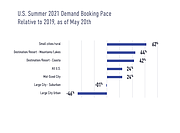Short-term rentals here for the long term
Tourism is a big player in the Kootenai County and Idaho state economy, the third largest industry for both entities.
That's why it's no surprise that leisure and hospitality opportunities have grown, including short-term vacation rental services like Airbnb, VRBO, and Vacasa.
Data developed by AirDNA, an Airbnb data and analytics company, shows that the number of Airbnb and HomeAway STR listings in Idaho — including entire home, private, and shared room availabilities — in October 2014 totaled 654.
By May 2021, AirDNA reported the number had increased by 1,291% to approximately 9,098. And 1,026 of those are located in Kootenai County.
AirDNA’s 2021 U.S. Short-term Rentals Economic Outlook reported that demand is surging in small-town and destination markets all over. Airbnb hosts sold 67% more listing nights in small cities and rural markets in 2020 than in 2019.
In Airbnb’s May 2021 report in Travel & Living, Idaho was the third “top-trending U.S. state destination.”
There were 149 Kootenai County locations listed on Airbnb as “available” for a weekend stay in August. More than 300 places were available during the week.
In Coeur d’Alene alone, 300 locations were available for an August midweek stay and even more for those interested in a weekend vacation.
Statewide visitation will likely be up 12% from the fiscal year 2020, which is “incredible considering it was done in a pandemic,” said Matt Borud, the Idaho Department of Commerce Marketing and Innovation Administrator.
Idaho’s tourism industry is also looking at a performance increase, he said, of about 8%.
Like many agencies, IDC didn’t anticipate any positive development coming out of the pandemic, Borud said. Much to his surprise, the upward trend of visitation and tourism Idaho saw before COVID-19 was not only sustained but accelerated over the past 13 months.
“We started seeing indicators last fall in Region 1, which is Coeur d’Alene and the five counties up there around Kootenai County, that tourism was up in August of last year,” Borud said. “It was insane to us that you guys were growing over the previous August.”
Idaho is typically what the Idaho Department of Commerce calls “a drive market,” meaning residents of neighboring states and internal travelers take the scenic route by vehicle.
The majority of visitors originate from Washington, Montana, Utah, and California, Borud said. This factor, he explained, positioned Idaho's tourism economy to stay airborne when air travel crashed during the pandemic.
“Last summer was the Year of the Road Trip,” Borud said. “Looking at our drive market visitation, we saw a strong increase in people from Seattle, Salt Lake, Spokane to a degree, Portland and California.”
During the 2021 Idaho Tourism Virtual Tourism Statewide Industry Meeting in March, the Idaho Department of Commerce reported that Region 1, the five Panhandle counties, saw a 7.4% increase in tourism revenue from January 2020 to January 2021 — only 3.4% less than the increase seen in the area the year prior.
In the “age of COVID-19,” as Borud called it, vacation rentals became more appealing.
According to the study, about 95% of summer 2021 Airbnb travelers booked entire homes, compared to 80% in summer 2019. Reasons for the increased interest in homestyle living while traveling, the report said, are homes offer the ability to “meet people’s new needs by being safe, everywhere, and designed for living and gathering with others in the kitchen or living room.”
“We saw a significant affinity for rentals as people figured out what the new normal for travel looked like. Even hotels refined safety protocols,” Borud said. “I don’t think anyone did it better than in your neck of the woods, but that wasn’t the case nationwide.”
Short-term rentals, much like other traditional means of lodging, benefit the state economy by encouraging people to get out, eat, play, and go to venues and activities, Borud said. Despite the notable increase in STR use, he quickly noted that hotels and other “traditional” options also had record years.
The IDC is collecting data for an economic impact report. Typically that report is produced every two years. The department chose to pause in spring 2020 to include COVID-19 data. Still, Borud said they don’t expect a significant adverse impact.
“The way it worked out, I think we avoided the calamity. As long as we continue having the outdoors, wonderful attractions, and industries, I think we are in a great place,” Borud said. “North Idaho tourism especially is an extremely well-oiled machine.”











